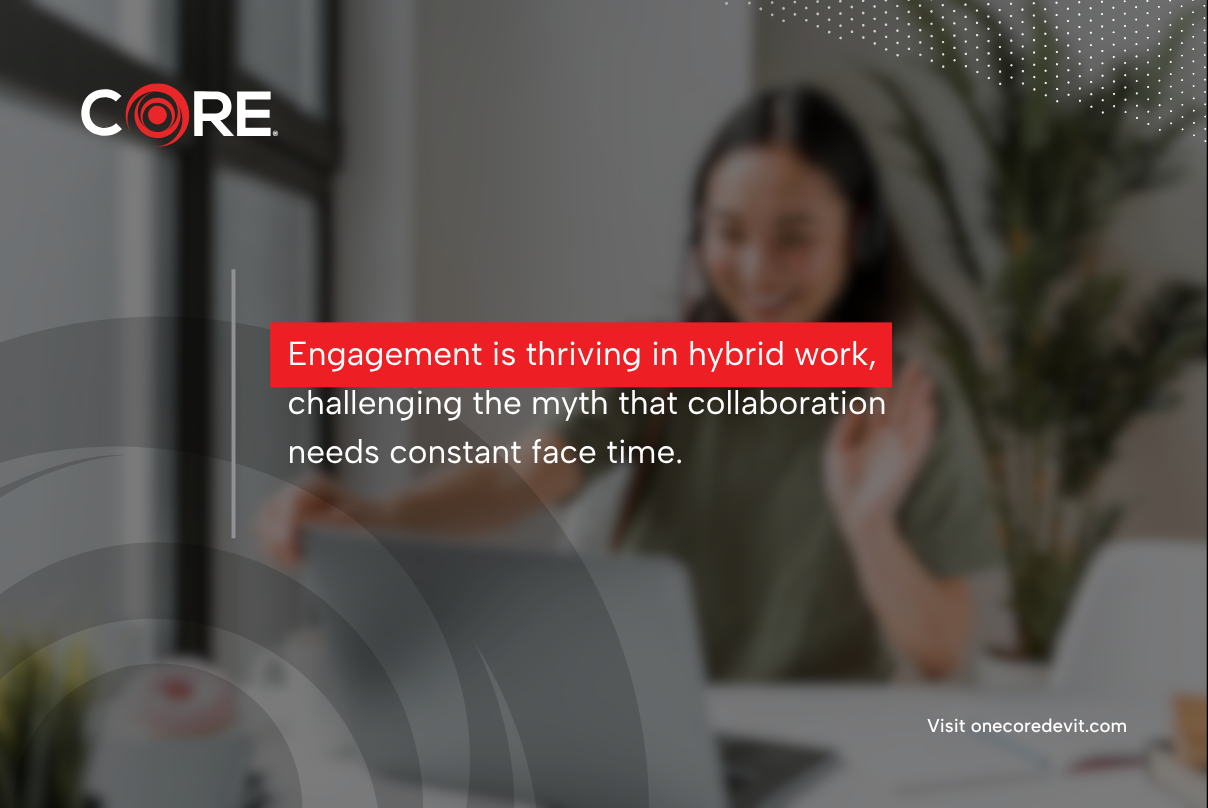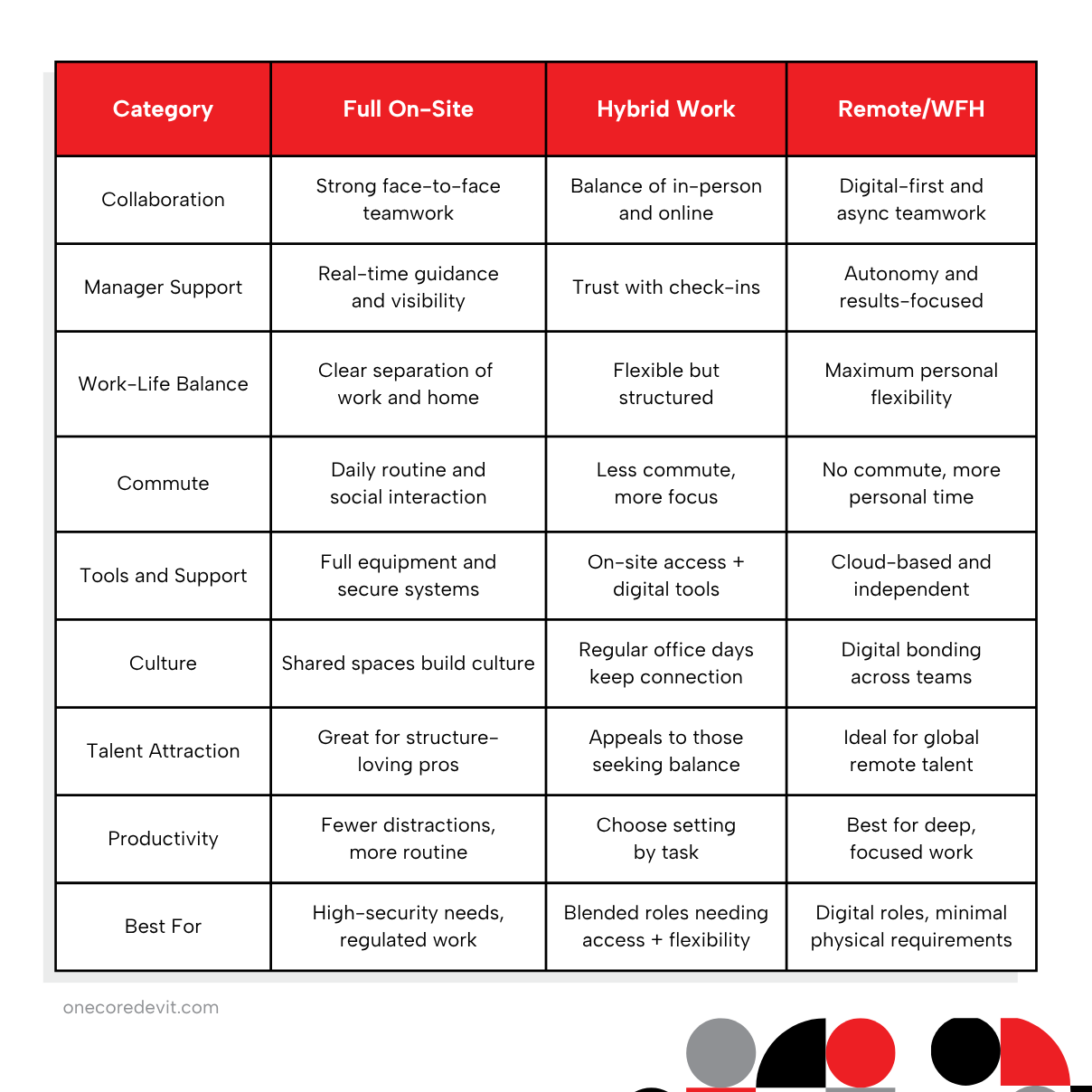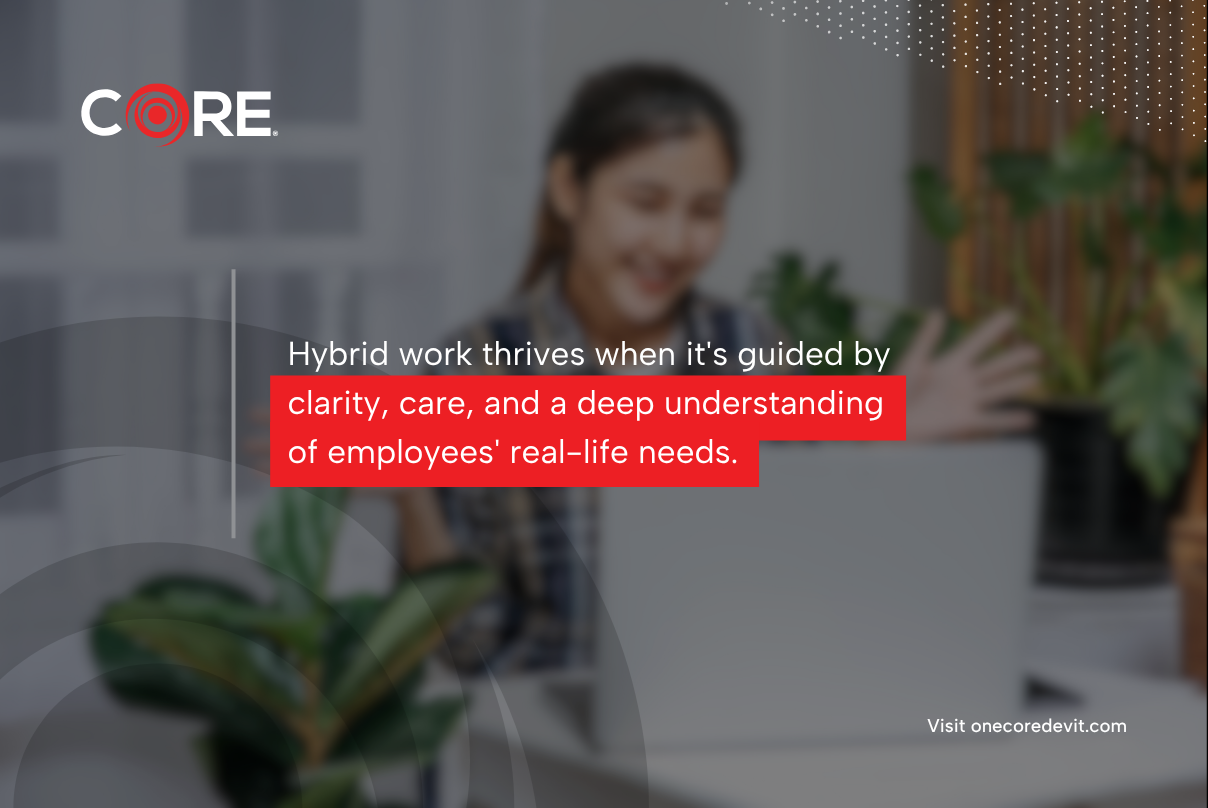The Rise of Hybrid Work in the Philippines
Hybrid work in the Philippines is transforming how companies operate and how employees experience their work in modern, flexible setups. According to a study, 52% of Filipino workers now follow hybrid schedules that combine office and remote workdays. Meanwhile, 91% of Filipino professionals prefer hybrid or remote work over a full-time office arrangement. This signals that hybrid work is not just a temporary shift; it’s quickly becoming the standard for modern work in the Philippines.
Moreover, 73% of Filipino employees say hybrid work improves productivity and well-being. That number speaks volumes about its benefits. This growing demand shows why hybrid work in the Philippines is worth your attention, whether you lead a team or are part of one.
Explore how hybrid setups affect satisfaction, and how businesses can create fl exible, effective policies that drive success. We’ll also cover key benefits, common challenges, and actionable strategies to make hybrid work in the Philippines work for everyone.
Current Trends in Hybrid Work Philippines for 2025
The hybrid work in the Philippines landscape continues to evolve in 2025, shaped by global trends and local workplace realities.
Adoption Rates and Implementation
As mentioned, 52% of Filipino workers now follow hybrid work setups. This rapid growth highlights how hybrid work has shifted from a temporary solution to a long-term workforce strategy across industries. Industries with the highest adoption include IT, business process outsourcing (BPO), and financial services.
Many companies have redesigned offices into flexible collaboration hubs, rather than spaces filled with individual desks. This shift shows how the role of physical offices is changing to match evolving work behaviors and expectations.
Factors Driving Adoption
Several factors are accelerating the adoption of hybrid work in the Philippines arrangements:
- Traffic congestion: Metro Manila workers spend hours daily commuting. Hybrid work helps reduce stress and time loss.
- Cost savings: Employers cut facility expenses. Employees save on fuel, transportation, meals, and other daily costs.
- Talent retention: Globally, 47% of workers may quit if forced into full-time office setups. Hybrid helps Filipino firms keep top talent.
- Technology adoption: Digital tools for communication and collaboration are more accessible and familiar, making hybrid work easier to manage.
- Employee expectations: Millennials and Gen Z dominate the workforce and strongly prefer flexible work options, including hybrid and remote arrangements.
Related post: How AI in Offshoring Philippines Is Revolutionizing the Workforce

How Hybrid Work in the Philippines Impacts Employee Satisfaction
The link between hybrid work in the Philippines and employee satisfaction is strong and increasingly backed by emerging data. Research shows well-designed hybrid models significantly improve how employees feel about their jobs, teams, and companies.
Employee Engagement and Hybrid Work
Hybrid setups also influence engagement. Filipino workers are somehow connected, even while working remotely part of the time. According to PeopleHum, 43% of Filipino employees feel fully connected to their teams under hybrid arrangements. This challenges the belief that physical presence is required for strong collaboration or engagement.
Effective hybrid work in the Philippines is producing:
- More active participation in meetings
- Better cross-team knowledge sharing
- Stronger communication habits
- Increased employee contributions and feedback
When done right, hybrid models don’t reduce connection; they actually strengthen workplace participation and team energy.
Cultural Considerations in the Philippines
The effectiveness of hybrid work in the Philippines depends on understanding local cultural dynamics.
- Family-oriented values: Filipino employees value flexible time to fulfill family duties and responsibilities.
- Bayanihan spirit: This cultural value encourages collaboration and thrives even in hybrid, remote-first teams.
- High-context communication: Filipino communication relies on non-verbal cues, so clear digital channels are essential in hybrid environments.
- Respect for hierarchy: Traditional leadership respect can create uncertainty. Guidelines and empowerment help bridge that gap.
Organizations that succeed with hybrid work in the Philippines respect and adapt to these cultural realities.
Productivity and Work-Life Balance Benefits
One major benefit of hybrid work in the Philippines is its impact on productivity and work-life balance, both crucial to employee satisfaction.
Productivity in Hybrid Settings
Studies show productivity improves when employees work under hybrid setups. Flexibility leads to better focus and task completion. Based on a report, 79% have enhanced their quality of work, and 66% have improved their job knowledge and skills. This challenges early concerns that remote work might reduce output and motivation over time.
Several factors contribute to this productivity boost:
- Reduced commute fatigue: Employees save a lot of hours per week that would otherwise be spent in Manila traffic, starting work with more energy.
- Environment flexibility: Employees can choose the most suitable environment for different types of tasks, quiet, focused work at home and collaborative projects in the office.
- Fewer interruptions: Days working from home typically feature fewer impromptu meetings and casual interruptions, allowing for deeper focus on complex tasks.
- Outcome-based evaluation: Many organizations implementing hybrid work in the Philippines models have shifted to measuring results rather than hours worked, encouraging efficiency and innovation.
Clear goals and structured expectations support these gains. Companies with set schedules and communication rules report the best productivity results.
Work-Life Balance Improvements
Better work-life balance is a widely recognized advantage of hybrid models. The setup gives employees more control over their schedules. Hybrid work in the Philippines enables professionals to meet job goals while handling family, health, and personal well-being needs.
In the Philippine context, this benefit is especially meaningful due to:
- Family responsibilities: Many Filipino workers care for both children and older relatives, often balancing roles throughout the day.
- Provincial living: Some employees split time between the office and provincial homes, spending more days with family members.
- Personal health: Less travel means more time for rest, exercise, home cooking, and other self-care practices.
Flexible hybrid hours let employees work during peak focus times while attending home responsibilities before or after.
Full On-Site vs. Remote vs. Hybrid Work Models: A Comparison

Choosing the right setup depends on your team’s needs, from security to flexibility. Hybrid work in the Philippines offers a balanced solution for businesses aiming to stay agile. Whether onsite, hybrid, or remote, what matters most is aligning your setup with your goals. Let your work model support both your people and performance.
Creating an Effective Hybrid Work From Home Policy
A strong hybrid work from home policy is essential for successful implementation, especially with the rise of hybrid work in the Philippines. To avoid confusion, your hybrid policy should clearly outline expectations for both remote and in-office work.
Key Elements to Include
An effective hybrid work from home policy helps prevent common issues before they arise through clear, well-defined guidelines.
Based on local company practices, here are key elements to include in your hybrid policy:
- Eligibility Criteria
Identify roles allowed to work hybrid, and the conditions or performance levels needed for approval. - Schedule Expectations
Set clear in-office days or shared working hours. Some Philippine firms follow a 3:2 (office: remote) weekly schedule. - Communication Protocols
Clarify preferred tools, response times, and participation expectations for meetings and project check-ins. - Performance Measurement
Focus on results over hours. Use KPIs, weekly reports, or feedback sessions to evaluate productivity. - Equipment and Expense Policies
List the devices your company provides and specify reimbursements for home office needs or internet costs. - Security Requirements
Highlight data privacy rules, secure logins, and compliance with the Data Privacy Act of 2012. - Collaboration Guidelines
Define when face-to-face meetings are needed and how virtual teamwork is expected to happen. - Flexible Hybrid Working Hours
Allow flexible schedules while making sure essential roles have adequate coverage and accountability.
Reviewing a sample hybrid work policy can provide valuable insights for creating your own guidelines.
Implementation Strategies
Understanding how to implement hybrid working effectively requires careful planning and communication.
Follow these practical steps to implement a hybrid policy effectively:
- Assess Readiness
Evaluate if your team has the right tools, leadership support, and openness to hybrid work. - Pilot Program
Run a short trial with select teams to identify early challenges and gather feedback. - Manager Training
Train leaders to manage hybrid teams through outcome-focused supervision and open communication. - Regular Feedback Loops
Use pulse surveys or check-ins to collect feedback and make timely improvements. - Technology Investment
Ensure access to communication, project tracking, and cybersecurity tools for seamless remote work. - Policy Refinement
Adjust your policy regularly based on feedback, team experience, and changing business needs.
This guide provides step-by-step instructions on how to implement hybrid working in your organization, with special consideration for the Philippine context.
Overcoming Challenges in Hybrid Work Philippines Implementation
While the benefits of hybrid work models are strong, implementing them comes with several key organizational challenges. Addressing these challenges early helps improve employee experience and boost your hybrid work program’s long-term success.
Infrastructure and Technology Challenges
Hybrid work in the Philippines must overcome infrastructure gaps that affect employee productivity and connection across regions.
- Internet connectivity
Despite improvements, internet service remains unreliable in some areas, affecting remote work stability and employee performance. 91% of Filipinos think better broadband is vital for hybrid work success. Organizations are solving this by offering internet allowances, using co-working hubs, and building backup systems for connectivity issues. - Power interruptions:
Regular brownouts occur in many provinces, disrupting work and creating stress for remote employees. Common solutions include UPS units for key roles, deadline flexibility, and alternative work options during storms - Technology access:
Many employees still lack access to consistent digital tools and stable connections at home. To fix this, companies provide tech stipends, standard devices, and training on tools for remote collaboration.
Management and Cultural Adjustments
Moving to hybrid work setups requires leaders to rethink management, build trust, and adjust company culture.
- Trust and micromanagement
Hybrid work fails when managers cling to old habits focused on visibility and control. Effective organizations train managers in outcome-based leadership and create structures that support autonomy and regular check-ins, not surveillance. - Communication challenges
In hybrid settings, clarity and consistency in communication are more important than ever. Organizations succeed by documenting decisions, setting channel guidelines, and creating team rituals that strengthen connections and communication. - Equity concerns
Fair treatment of remote and onsite workers is essential to a thriving hybrid culture. Many teams use “meeting equality” rules, rotate meeting times, and redesign recognition and promotion practices to be inclusive.
Employee Experience Considerations
Engagement must be built intentionally in hybrid work models to keep teams connected and motivated.
- Onboarding: Design virtual onboarding programs that clearly communicate roles and foster strong team relationships.
- Mental health: Offer support for remote workers facing isolation, burnout, or stress caused by inconsistent conditions.
- Career development: Ensure access to learning, mentorship, and advancement is equal for in-office and remote employees.
- Team building: Provide meaningful virtual and in-person ways for teams to bond and collaborate.
By addressing these challenges, hybrid work models in the Philippines can increase employee satisfaction and strengthen business results across locations.
The Future of Hybrid Work in the Philippines
Remote work trends show that hybrid work in the Philippines will likely remain the dominant setup in the coming years. Understanding these trends helps companies create hybrid policies that stay flexible, relevant, and effective over time.
Emerging Trends to Watch
Several developments are influencing the future of hybrid work in the Philippines:
- AI integration: More teams are using AI tools to support decision-making and improve collaboration in hybrid and remote work setups.
- Automation of routine tasks: As more tasks become automated, the need for constant in-person work is decreasing across many roles.
- Evolution of office spaces: Workplaces are shifting from rows of desks to more flexible spaces that encourage teamwork and in-person collaboration.
- Four-day work weeks: Some organizations are exploring shorter workweeks alongside hybrid models to give employees greater flexibility and balance.
- Hybrid recruitment Hiring methods are evolving to combine in-person and digital approaches. Organizations are increasingly turning to hybrid recruitment methods to attract top talent from across the Philippines and globally.
Long-term Impact on the Philippine Workforce
The rise of hybrid work in the Philippines is expected to create lasting changes in how and where people work:
- Geographic Distribution: With less need to report to the office daily, many professionals are choosing to live in areas outside major cities.
- Global Opportunities: Filipino professionals can explore more international job roles while continuing to live and work from the Philippines.
- Skill Development: Skills like digital communication, time management, and independent work are becoming more valuable in hybrid setups.
- Infrastructure Investment: As hybrid work becomes more common, there is growing interest in improving internet connectivity and digital tools.
- Work Culture Evolution: Many companies are focusing less on hours worked and more on results, encouraging a culture of trust and accountability.
These changes suggest that hybrid work arrangements in the Philippines will continue to evolve.
Related post: Remote Work Trend Philippines: What US Employers Need to Know in 2025

Embracing the Hybrid Future
The shift to hybrid work in the Philippines reflects a growing need for flexibility in today’s evolving work environment. More professionals now seek work setups that help them balance personal responsibilities while staying productive and engaged in their roles.
Organizations that set clear hybrid work-from-home guidelines and understand local needs can improve satisfaction, attract talent, and boost retention. Moreover, thoughtful hybrid models help create an environment where both employees and businesses can thrive through flexibility and better work-life integration.
As you shape your hybrid work in the Philippines strategy, focus on planning intentionally, communicating clearly, and adapting to change.
Frequently Asked Questions (FAQs)
Q1: What are the essential elements of a hybrid work policy?
A comprehensive hybrid work policy should include eligibility criteria, schedule expectations, communication protocols, performance measurement guidelines, equipment and expense policies, security requirements, collaboration guidelines, and parameters around flexible working hours. Each organization should tailor these elements to their specific needs and culture.
Q2: How can managers effectively lead hybrid teams in the Philippines?
Effective management of hybrid teams requires shifting from visibility-based to outcome-based performance evaluation, establishing clear communication protocols, ensuring equity between remote and in-office employees, providing appropriate technology support.
Q3: Can I work remotely for a US company from the Philippines?
Yes, you can work remotely for a US company from the Philippines, as long as both parties comply with legal and tax requirements. It’s important to clarify your employment status, whether as an independent contractor or through an Employer of Record, to ensure compliance with local labor and tax laws.
Q4: Is it legal to work two jobs in the Philippines?
Yes, it is generally legal to work two jobs in the Philippines, unless your primary employment contract includes a non-compete or exclusivity clause. Just make sure both jobs don’t conflict with each other and you follow proper labor and tax regulations.
Q5: Is work from home still allowed in the Philippines?
Yes, work from home is still allowed and widely practiced in the Philippines, especially in the BPO, IT, and creative sectors. Many companies have adopted flexible or hybrid work setups even beyond the pandemic.
Q6: What is an example of a hybrid business in the Philippines?
An example of a hybrid business in the Philippines is a tech startup that allows employees to work in-office three days a week and remotely for the rest. Many BPO firms and shared services centers now operate with similar hybrid models.
The rise of hybrid work models in the Philippines is reshaping employee expectations, with satisfaction often hinging on flexibility and employer support. As organizations adjust to this new reality, the need for dependable workforce solutions becomes clear. CORE® steps in with comprehensive services that go beyond recruitment; we handle compliance, hiring, and provide continuous operational support. Let us help you build a future-ready workforce. Reach out to us now!





